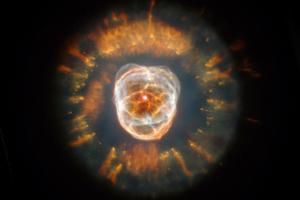Blog
Star Dates
10 April 2014
 NASA, ESA, Andrew Fruchter (STScI), and the ERO team (STScI + ST-ECF)
NASA, ESA, Andrew Fruchter (STScI), and the ERO team (STScI + ST-ECF)Determining the age of a star poses a bit of a challenge for astronomers. After all, stars exist over a timescale of billions of years, and they are light years away. We can’t use radiometric dating like we do for rocks and other objects on Earth. So just how do we determine the age of a star? It turns out that there are several ways, and it’s getting easier to do.
One of the ways is to compare a star’s mass with its brightness (absolute magnitude). We can determine the mass of a star if it is part of a binary system, and if we have a good measure of its distance (say, through its parallax) then we can observe its apparent magnitude and use its distance to determine its absolute magnitude. The way we determine its age is by recognizing that main sequence stars grow hotter and brighter over time. Stars produce light and heat through nuclear fusion in their core. As more hydrogen fuses into helium, the fusion rates gradually increase, producing more heat and light. So for stars of a particular mass, brighter stars are older than dimmer stars. By observing stars that are newly formed and stars at the end of their life we have an idea of the rate at which stars brighten over time, so we can get a measure of a star’s age.
Another way is to measure a star’s rate of rotation. For stars around a solar mass or less, the rate of rotation of a star gradually decreases. So the rotation rate of a star depends upon its mass and age. By measuring the rotation of a star and comparing it to the rotation of the Sun (for which we know its age very well), we can determine its age.
There are a few downsides with these age measurements. For one, they only work with main sequence stars, so very young and very old stars need to be studied with different measures. For another, they depend upon measurements that have traditionally been challenging to do well. But a new method presented in the Astrophysical Journal could provide an easier and more effective way to determine stellar ages.1
The method uses what is known as helioseismology, which is the study of sonic oscillations within a star. Helioseismology has long been used to study the interior structure of the Sun, but more recently it can also be used with stars. Since the frequency of sound oscillations depends upon the mass and density of a star, helioseismology can be used to determine the mass and radius of a star pretty effectively. Knowing that, one can use observations of a star’s spectrum to determine its temperature. The mass, radius and temperature of a star can then be used to determine its age.
What makes this new method potentially powerful is that it depends upon the type of observational data gathered by sky surveys. This initial study looked at about a thousand stars. A larger project known as the Stroemgren survey for Asteroseismology and Galactic Archaeology (SAGA) is analyzing data gathered by the Kepler telescope. Future observations by telescopes such as GAIA could provide a large survey of stellar ages within our galaxy.
The reason why this is important is that knowing the age of a large number of stars allows us to study the history of our galaxy. By analyzing stellar ages, we can determine when star production was common, and when it was rare. We might even be able to determine past collisions with our galaxy, which tend to drive star production. This new method is still young, so it will take time to determine if it lives up to its potential. But if it does we may soon gain deeper understanding of the history of our galaxy.
Casagrande, Luca, et al. “Stroemgren survey for Asteroseismology and Galactic Archaeology: let the SAGA begin.” The Astrophysical Journal 787.2 (2014): 110. ↩︎